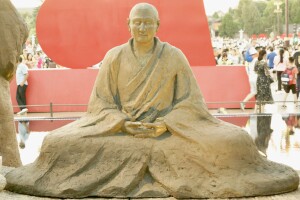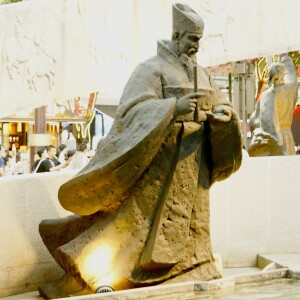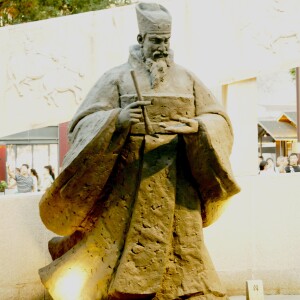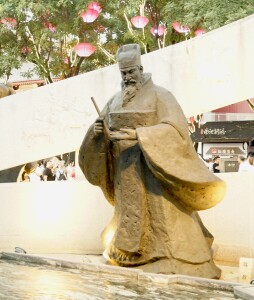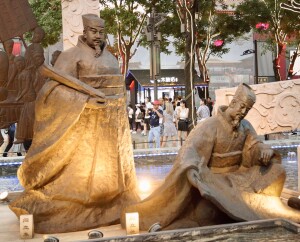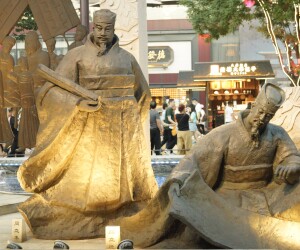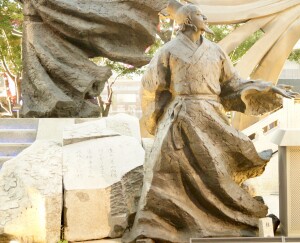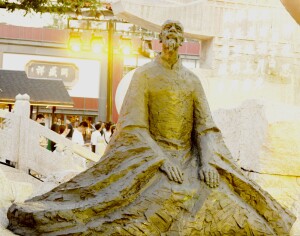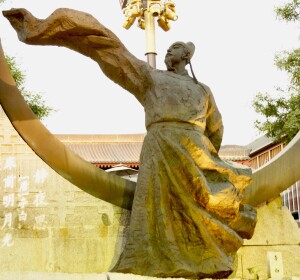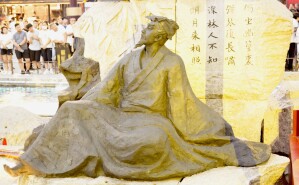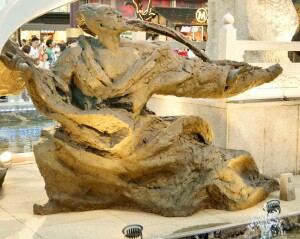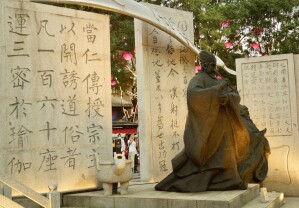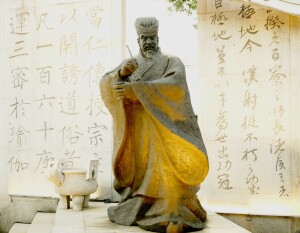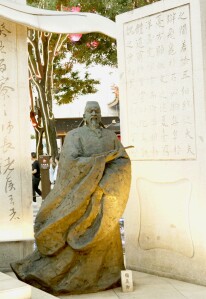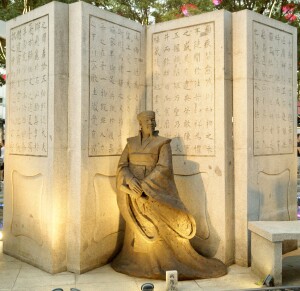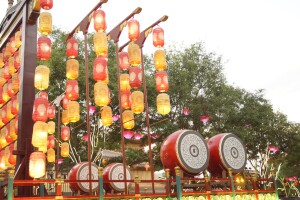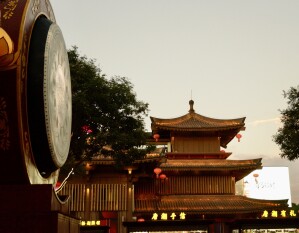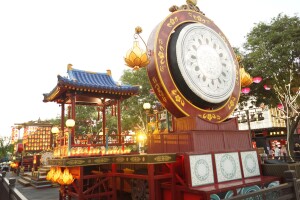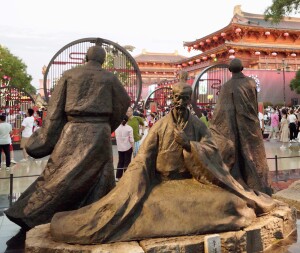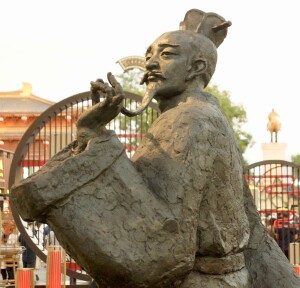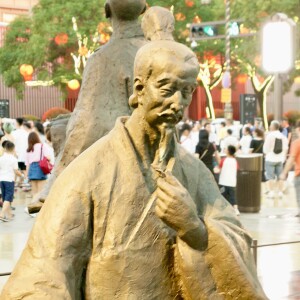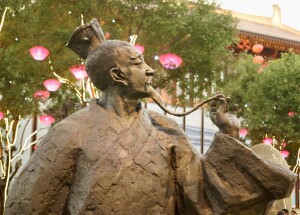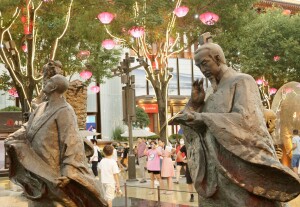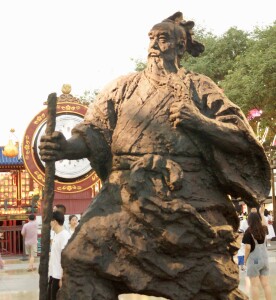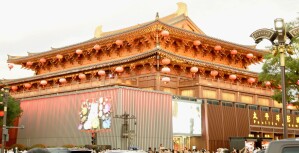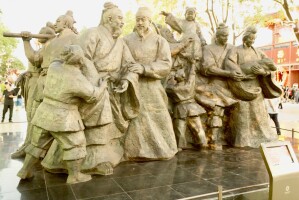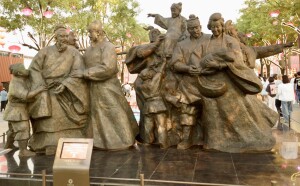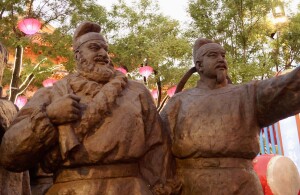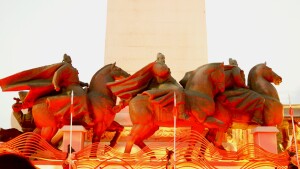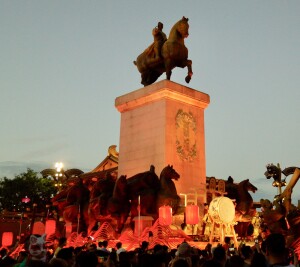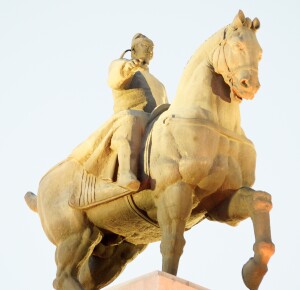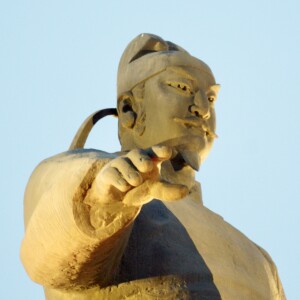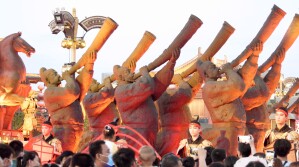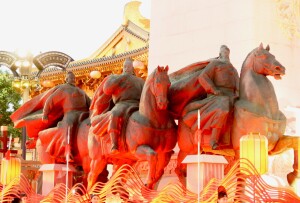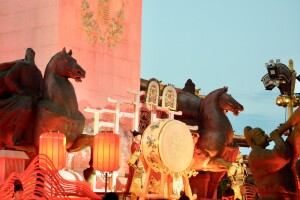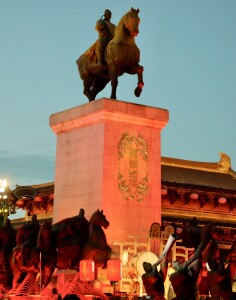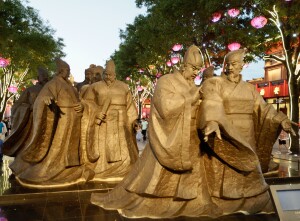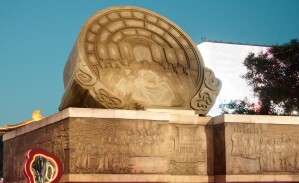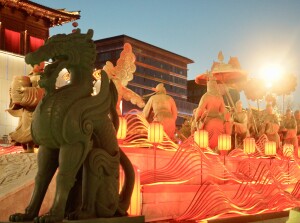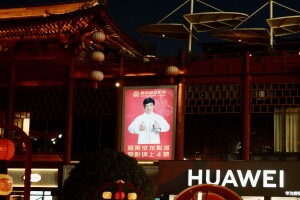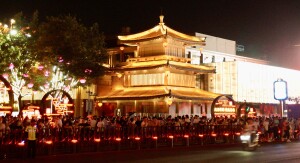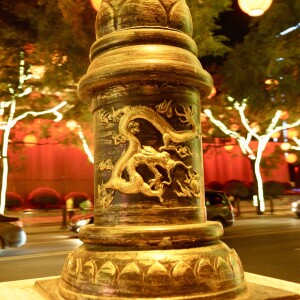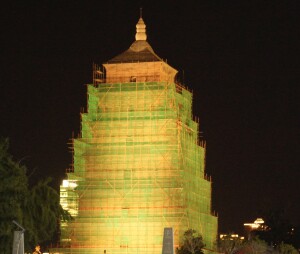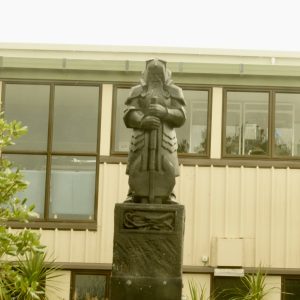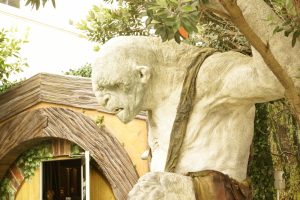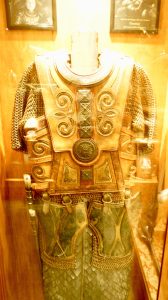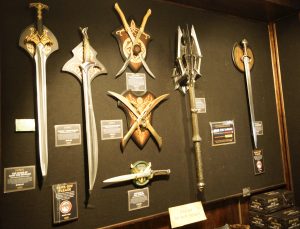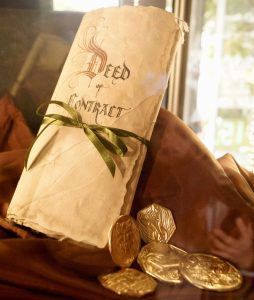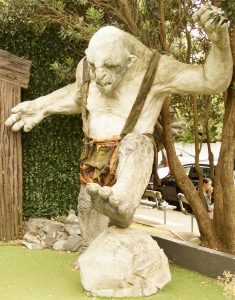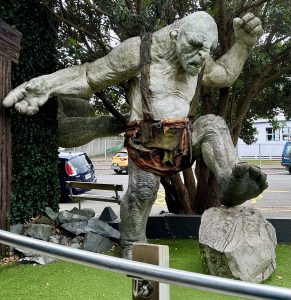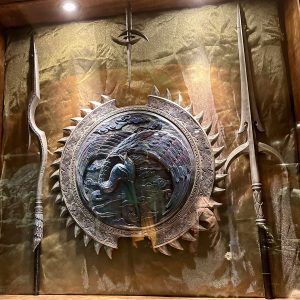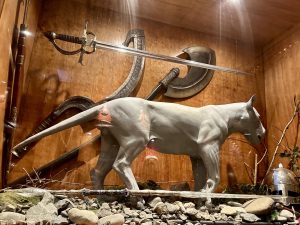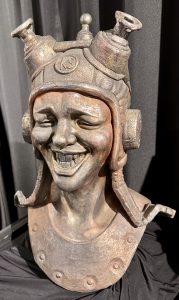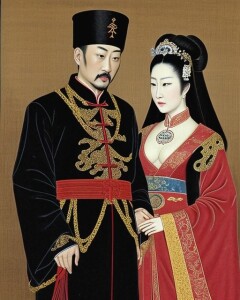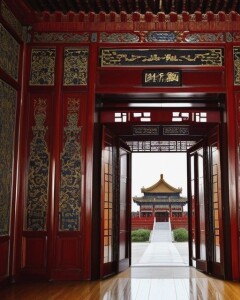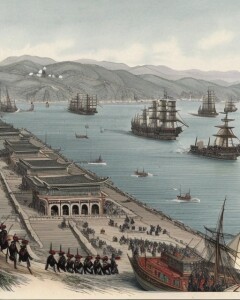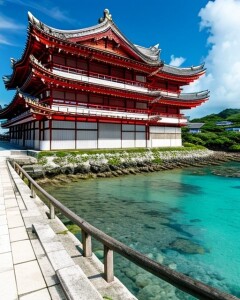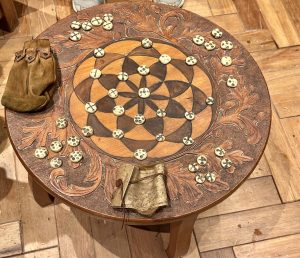J. Robert Oppenheimer: Architect of the Atom, Weaver of Scientific Ethics
J. Robert Oppenheimer, a prominent American physicist widely recognized as the “father of the atomic bomb,” played a pivotal role in the development of nuclear weapons during the turbulent era of World War II. Born on April 22, 1904, in the vibrant city of New York, Oppenheimer exhibited remarkable intellectual prowess from a young age. He embarked on his academic journey at Harvard University, immersing himself in the study of physics. Subsequently, he pursued his Ph.D. at the esteemed University of Göttingen in Germany. Oppenheimer’s scientific career soared when he joined the distinguished faculty at the University of California, Berkeley, making significant contributions to the field of theoretical physics, with a particular focus on the enigmatic domain of quantum mechanics. However, it was his unwavering commitment to the Manhattan Project that irrevocably altered both his own life and the course of history.
In 1942, Oppenheimer was appointed as the esteemed scientific director of the covert and classified Manhattan Project, a highly secretive government initiative aimed at unraveling the enigmas of atomic energy and harnessing its enormous potential to create an atomic bomb. Under his exemplary leadership, a group of brilliant scientists and engineers worked tirelessly, united by the common objective of unraveling the complexities of nuclear fission. Oppenheimer’s exceptional organizational skills and ability to bring together individuals from diverse disciplines proved pivotal in the project’s resounding success. Armed with his unparalleled intellect and profound insights into the realm of physics, he expertly navigated numerous scientific obstacles with determination, each challenge only enhancing his unassailable reputation.
Amidst the weighty pressures and profound moral dilemmas associated with the development of such a devastating weapon, Oppenheimer’s unwavering dedication to his craft remained intact. The momentous and historic Trinity test in July 1945 stands as an indelible turning point in human history. The successful detonation of the first atomic bomb symbolized the unleashing of unparalleled destructive power, ultimately leading to the bombings of Hiroshima and Nagasaki in Japan, hastening the end of the cataclysmic World War II.
Nevertheless, Oppenheimer’s involvement in the Manhattan Project cast a shadow of ambiguity over his previously illustrious legacy. After the war, he emerged as a staunch advocate for international control of atomic weapons, expressing fervent concerns about the perilous arms race that loomed. Unfortunately, Oppenheimer’s progressive views and perceived associations with politically left-leaning groups during the McCarthy era inevitably resulted in accusations of disloyalty and alleged sympathies with communist ideologies. In 1954, he underwent a highly charged security hearing and, despite his invaluable contributions to national security, unjustly had his security clearance revoked.
Undeterred by these personal and professional setbacks, Oppenheimer tenaciously continued to make exceptional contributions to the scientific community. He resolutely returned to his true passion, teaching and engaging in research at the prestigious Institute for Advanced Study in Princeton, where he nurtured and mentored a forthcoming generation of physicists, leaving an indelible imprint on the realm of knowledge. Beyond his groundbreaking scientific achievements, the profound impact of Oppenheimer’s intellectual brilliance, inspiring leadership, and unwavering commitment to the ethical dimensions of scientific inquiry resonate through the annals of time.
The life and work of J. Robert Oppenheimer epitomize the intricately woven tapestry of science, politics, and morality. While his role in the development of the atomic bomb remains a contentious subject, his broader contributions to the advancement of physics cannot be easily dismissed or overlooked. Oppenheimer’s legacy serves as an enduring reminder of the immense power and weighty responsibility that inevitably accompany scientific breakthroughs, compelling us to continuously consider the ethical implications that underlie every action we undertake.
Dick Move Band Lives Up to Their Name
The concert lineup for the night featured three bands, with Dick Move kicking off the event, followed by The Breeders, and finally, the Foo Fighters headlining the show. Dick Move, although being the opening act, unfortunately failed to impress the crowd with their performance. Their sound was characterized by a lack of clarity, making it difficult to understand the lyrics or any message they were trying to convey. Moreover, their songs seemed to blend together, lacking diversity and originality. As they concluded their set and made their way off the stage, they decided to voice their political opinions by shouting “Free Palestine.” However, this unexpected political statement was met with disapproval from the audience. Understandably, concertgoers attend live shows to enjoy the music and escape from the political climate, rather than being confronted with divisive topics. Consequently, their politically charged outburst was not well-received, with many attendees feeling that it was inappropriate and unwelcome.
Unyielding Valor: The Saga of William Wallace, Scotland’s Eternal Hero
In the annals of Scottish history, one name stands out like a beacon of hope and defiance: William Wallace. Born in the tumultuous era of the late 13th century, Wallace would rise to become a legendary figure, forever etched in the memories of his countrymen.
With a spirit untamed by English oppression, Wallace emerged as a fierce leader, embodying the indomitable Scottish resistance. His presence alone struck fear into the hearts of his enemies. Renowned for his military genius and tactical brilliance, he orchestrated a series of triumphant campaigns against the English forces.
But it was at the Battle of Stirling Bridge where Wallace’s legend reached its zenith. With the odds stacked against them, the Scottish army, led by this fearless warrior, defied all expectations and achieved an astonishing victory. The reverberations of this momentous event echoed throughout the land, igniting a fire of nationalistic fervor that burned brighter than ever before.
Alas, the tides of fortune can be fickle, and Wallace’s glory was short-lived. The Battle of Falkirk dealt a crushing blow to his aspirations, leading to his capture and subsequent execution in 1305. Yet, even in death, his spirit refused to be extinguished.
The tale of William Wallace, the valiant knight who dared to challenge the might of a kingdom, captured the hearts and minds of generations. His legacy became an indelible symbol of Scottish resilience and the fight for independence. From the epic verses of Blind Harry’s “The Wallace” to the silver screen portrayal in the iconic film “Braveheart,” his story has resonated across time.
William Wallace, the embodiment of unwavering commitment and heroic deeds, continues to inspire and captivate. His name lives on, forever etched in the annals of Scottish history, as an enduring symbol of bravery, freedom, and the undying spirit of a nation.
Exploring the Wonders of Datang Everbright City in Xi’an
Datang Everbright City in Xi’an presents a captivating destination that effectively showcases the rich history and contemporary developments of China. Tucked away within the ancient city of Xi’an, this vibrant cultural complex offers a delightful fusion of traditional architecture and cutting-edge technology. As soon as you set foot here, you are instantly whisked away to a bygone era, greeted by splendid replicas of Tang Dynasty structures adorned with intricate carvings and vibrant hues. These architectural wonders not only provide visually pleasing sights but also offer a glimpse into the grandeur of the Tang Dynasty, widely regarded as the golden age of Chinese civilization. The meticulous attention to detail in their design and construction is truly commendable, making it an absolute must-visit for history buffs and architectural enthusiasts.
However, Datang Everbright City goes beyond being a mere historical site; it seamlessly integrates modern advancements to create an immersive and interactive experience for visitors. The Tang Paradise, a standout feature of this complex, is an enticing theme park that meticulously recreates the splendor of the Tang Dynasty. Here, one can explore breathtaking gardens, be mesmerized by captivating performances, and even take a serene boat ride across the picturesque lake. The clever use of cutting-edge technologies, such as awe-inspiring holographic projections and immersive virtual reality, adds an unparalleled charm to the overall experience, effectively bringing the history to life in the most captivating manner.
Another remarkable aspect of Datang Everbright City lies in its diverse range of cultural activities. From mesmerizing traditional Chinese dance performances and soul-stirring music concerts to captivating calligraphy demonstrations and elegant tea ceremonies, there is a plethora of engaging experiences catering to individual preferences. Moreover, visitors are provided with opportunities to participate in workshops where they can learn cherished traditional crafts like the delicate art of paper cutting and the exquisite mastery of silk embroidery. These activities allow participants to gain a profound understanding and appreciation for the rich tapestry of Chinese culture and artistic heritage.
Furthermore, Datang Everbright City takes its visitors on an extraordinary gastronomic journey through the flavors of ancient China. Within the complex, one can find a variety of exceptional restaurants and quaint food stalls serving delicious, authentic Tang Dynasty cuisine. Every dish, from the savory dumplings to the delectable sweet rice cakes, is meticulously prepared using traditional recipes and techniques, offering visitors an exquisite and authentic taste of the past.
Beyond its cultural and culinary wonders, Datang Everbright City also provides ample opportunities for relaxation and leisure. The expansive park surrounding the complex offers an idyllic setting for leisurely strolls amidst lush greenery or enjoyable picnics, providing a tranquil escape from the bustling city life. Additionally, numerous souvenir shops and boutiques are scattered throughout the complex, enticing visitors with unique handicrafts and treasured mementos that serve as tangible reminders of their extraordinary visit.
In conclusion, Datang Everbright City in Xi’an stands as an exceptional destination that seamlessly combines history, culture, and technology. Whether one finds themselves engrossed in the annals of the past, captivated by artistic marvels, or simply seeking an extraordinary and immersive experience, this cultural complex offers something truly extraordinary for every individual. Its meticulous attention to detail, interactive attractions enhanced by advanced technologies, and diverse range of engaging activities effortlessly establish it as a must-visit destination epitomizing the very best of ancient and modern China.
Echoes of Desolation: Unveiling the Tragedy of the Holodomor
The Holodomor, or the Ukrainian famine of 1932-1933, holds a stark place in Ukrainian history. This devastating event was orchestrated by the Soviet Union, specifically under Joseph Stalin’s leadership, with the intention of suppressing Ukrainian nationalism and enforcing agricultural collectivization. The policies implemented during this distressing period resulted in the loss of countless Ukrainian lives, positioning it as one of the most tragic and fatal famines in recorded human history.
Under the guidance of the Soviet government, Ukrainian peasants suffered the forcible seizure of their grain and other crucial food supplies. This left them devoid of sustenance for themselves and their families, enduring unimaginable deprivation. Heart-wrenching accounts depict individuals resorting to extreme measures such as consuming grass and bark, and in some instances, even resorting to the unimaginable act of consuming their own children in desperate attempts to survive.
The effects of this famine were not confined solely to physical suffering. They resonated deeply within Ukrainian culture and identity. The deliberate targeting of Ukrainians and the erosion of their way of life left lasting wounds, wounds that can still be felt today. The Ukrainian famine of 1932-1933 serves as a poignant reminder of the immeasurable toll inflicted by political oppression and the cold-hearted disregard for human life.
Above all, it stands as a testament to the indomitable resilience of the Ukrainian people. They have persistently strived to preserve their history and honor the memory of those who perished during this tragic era.
Caligula Unveiled: The Madness and Intrigue of Rome’s Most Infamous Emperor
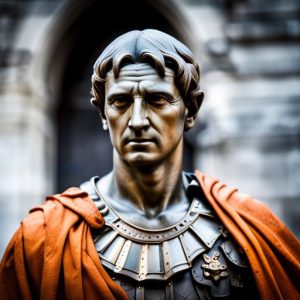
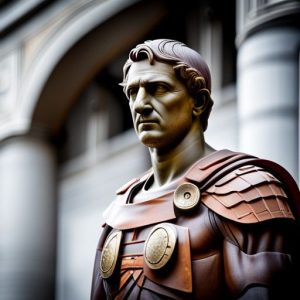
Get ready to witness the rise and fall of one of the most controversial figures in Roman history – Gaius Caesar Germanicus, also known as Caligula. Born in 12 AD as the third son of Germanicus, a beloved Roman general, and the granddaughter of Augustus, the first Roman emperor, Caligula was destined for greatness. With his charming looks, charisma, and wit, he was adored by the Roman people. However, his short-lived reign of only four years, from 37 AD to 41 AD, was nothing short of a rollercoaster ride filled with cruelty, extravagance, and madness.
Caligula’s ascension to the throne was relatively calm. Initially, he was a popular emperor who abolished unpopular taxes, restored democratic freedoms, and initiated massive building projects. However, it wasn’t long before things started spiraling out of control. Caligula’s behavior became increasingly erratic and bizarre, including donning women’s clothing and appointing his favorite horse as a consul.
The emperor’s cruelty was most evident in his treatment of the Roman Senate. He had many senators executed without any reason and publicly humiliated them. Caligula’s incestuous relationships with his sisters and rumored acts of extreme sexual depravity only added to his infamy. His reckless spending and taxation policies also put a tremendous strain on the Roman economy, leaving it in shambles.
But even with all his power, Caligula’s behavior eventually became too much for the people and the Senate to bear. In 41 AD, he met his demise at the hands of members of his own Praetorian Guard. Although his reign was short, Caligula’s legacy continues to fascinate historians and the public alike. He is remembered as one of Rome’s most notorious and eccentric emperors, whose reign serves as a cautionary tale about the dangers of absolute power.
The Art of Aging: Unveiling the Secrets of Okinawa Awamori
Okinawa awamori, which is an esteemed traditional distilled alcoholic beverage, holds a special place in the cultural heritage of Okinawa, Japan. It is deeply intertwined with the customs, traditions, and way of life on the island, with its origins dating back centuries. This exceptional libation is meticulously crafted using long-grain indica rice, undergoing a careful fermentation process with black koji mold and water. However, what truly sets this drink apart is its unique aging process; it is delicately entombed in traditional clay pots called kame and left to mature underground.
This underground seclusion allows the awamori to develop and unveil its complex flavors over time. The end result is an exquisite elixir that is both smooth and aromatic, boasting a distinctive taste profile with subtle undertones of tropical fruits, earthiness, and a gentle sweetness. The craftsmanship and quality of Okinawa awamori are highly esteemed, with many distilleries adhering to time-honored production methods passed down through generations. The production of awamori is not merely a skill; it is an artistic endeavor where master distillers devote their lives to perfecting this craft. Enthusiasts typically enjoy the spirit neat or over ice, relishing its intricate flavors sip by sip. Moreover, awamori imparts its distinct touch to various cocktails and culinary recipes, adding a unique flavor dimension to Okinawan cuisine.
Beyond its delightful taste, awamori carries significant cultural significance within Okinawan society. It takes center stage in traditional ceremonies, festivals, and celebrations, symbolizing unity and harmony while preserving local traditions. The spirit has also gained international recognition, attracting a growing interest among spirits connoisseurs worldwide who appreciate its exceptional qualities and cultural heritage. As a result, the production and consumption of Okinawa awamori continue to thrive, bolstering the island’s economy and sharing a valuable slice of Okinawan culture with the rest of the world.
Gabriel’s Grace: Illuminating the Path of Divine Communication
The celestial being known as Archangel Gabriel holds immense importance in the realm of heaven. Serving as the divine messenger, Gabriel specializes in conveying crucial announcements and enlightening revelations, acting as a bridge between the mortal world and the heavenly abode. Throughout various religious traditions, Gabriel has garnered great reverence as a respected figure, embodying the essence of divine guidance and spiritual enlightenment. Whether it involves delivering prophecies, imparting wisdom, or transmitting divine instructions, Gabriel’s role as the messenger angel assumes paramount significance in bridging the gap between humanity and the ethereal domain. With a gentle yet commanding demeanor, Gabriel brings forth messages that possess the potential to shape destinies, provide clarity, and initiate transformative change.
The name Gabriel holds profound meaning, signifying “God is my strength.” This further solidifies the belief that Gabriel serves as a source of divine power and protection, leading individuals towards their true purpose and nurturing their spiritual development. As the angel of communication, Gabriel’s celestial presence often accompanies moments of great importance, such as the annunciation to the Virgin Mary, wherein he revealed the impending birth of Jesus Christ. This particular event cemented Gabriel’s reputation as a dispenser of profound revelations and positioned him as a central figure in the Christian faith.
Extending beyond the boundaries of Christianity, Gabriel’s presence can also be found in other religious texts, such as the Quran, where he assumes a vital role in delivering divine messages to the Prophet Muhammad. Gabriel’s multifaceted nature goes beyond that of a mere messenger. Depicted frequently as a compassionate and nurturing figure, Gabriel offers solace and support to those in need. His angelic presence acts as a beacon of hope, reminding humanity of the infinite love and guidance bestowed upon them by the divine realm. In times of uncertainty and confusion, invoking the name of Gabriel can bring reassurance, clarity, and a sense of purpose. Whether individuals seek guidance, strive to deepen their spiritual connection, or simply yearn for divine intervention, Archangel Gabriel stands ready to assist, delivering messages of truth and enlightenment with unwavering grace and compassion.
Journey into Cinematic Enchantment: Exploring the Wonders of Weta Cave and Workshop
Prepare to be enthralled as I take you on an extraordinary expedition through the renowned marvels of the Weta Cave and Weta Workshop, nestled in the idyllic city of Wellington, New Zealand. These exceptional sites have left an indelible mark on the domain of film and special effects, captivating audiences with their monumental contributions to the artistry of cinema.
Immerse yourself in the enchanting realm of the Weta Cave, which acts as a gateway to the mystical world of the esteemed Weta Workshop. This distinguished company has lent its artistic prowess to blockbuster films such as the legendary “The Lord of the Rings” trilogy, the visually stunning “Avatar,” and the gripping tale of “King Kong.” As you step inside, get ready to be captivated by a plethora of mesmerizing exhibits that meticulously showcase the craftsmanship and painstaking attention to detail behind the creation of intricate props, costumes, and fantastical creatures that grace the silver screen.
Now, brace yourself as the Weta Cave beautifully breathes life into menacing Orcs roaming Middle-earth and the awe-inspiring Na’vi inhabitants of Pandora, enveloping visitors in the sheer enchantment of filmmaking. Traverse through the bustling haven of creativity that is the Workshop itself and feast your eyes on the process that transforms imagination into tangible reality.
Within the Workshop, skilled artisans and technicians pour their heart and soul into translating the visions of filmmakers into vivid realities. This inexhaustible haven of imagination blurs the boundaries between reality and fantasy, granting resolute freedom to the creative spirit. With guided tours, visitors are generously invited into this realm of cinematic marvels, offering an up-close and personal encounter with the intricate processes that underpin the creation of awe-inspiring movie magic.
From the sculpting of exquisite models to the artistry of digital design and the mesmerizing mastery of animatronics, the Workshop provides an unparalleled insight into the captivating world of special effects. While treading the paths of creative ingenuity, visitors find themselves enveloped in a treasure trove of memorabilia, including iconic props, awe-inspiring costumes, and thought-provoking concept art from some of the most cherished films in the annals of cinematic history. It is indeed a sanctuary for film enthusiasts and a profound testament to the limitless power of boundless imagination.
However, the allure of the Weta Cave and Weta Workshop extends beyond their exceptional offerings. These extraordinary establishments have solidified Wellington’s status as a prestigious hub for film production. Their influence not only graces the silver screen but also ignites the imaginations of countless aspiring artists and filmmakers worldwide. Their enduring legacy serves as a testament to what boundless creativity and unwavering passion can accomplish when they harmoniously converge.
I implore you to embark on this awe-inspiring cinematic pilgrimage to the Weta Cave and Weta Workshop, allowing yourself to be swept away by the wondrous feats of craftsmanship and innovation that undeniably reshape the world of film and special effects. Embrace the inspiration that permeates these revered halls, and witness your own imagination flourish in uncharted territories. For within these realms, the magic of storytelling finds its truest expression.
Revolutionizing Roles: The Dynamic Journey of Russian Women in Communist Society
Russian women played a significant and transformative role in Communist society, undergoing remarkable changes in their social, economic, and political status. The Communist regime aimed to establish gender equality, providing women with unprecedented opportunities that were previously inaccessible. In the early years of the Soviet Union, women were actively encouraged to enter the workforce, defying traditional gender norms that had confined them for centuries. They were granted equal access to education and employment, empowering them to pursue a wide range of careers. This newfound independence emboldened Russian women to challenge deeply ingrained patriarchal conventions and actively contribute to the progress of their nation.
While it is important to acknowledge the progress that was made, it is equally important to recognize that achieving complete gender equality remained a challenging goal within Communist society. Women often faced barriers such as gender-based discrimination, wage disparities, limited job prospects, and restricted access to leadership positions. Despite these challenges, Russian women exhibited remarkable resilience and made significant contributions across various fields including science, literature, arts, and politics. This era witnessed the emergence of remarkable figures such as Valentina Tereshkova, the trailblazing first woman in space, and Aleksandra Kollontai, an influential feminist and politician.
Furthermore, the Communist regime implemented policies to support working mothers, including measures to provide affordable childcare and maternity leave provisions. These efforts aimed to alleviate the burdens faced by women as they navigated their professional and familial responsibilities. However, it is essential to acknowledge that the Communist government’s approach to women’s rights was not solely motivated by a commitment to gender equality. Rather, it was driven by their recognition of the valuable contributions that women could make in building a strong and prosperous nation.
In conclusion, Russian women experienced a complex interplay of progress and challenges within Communist society. They seized the newfound opportunities available to them, shattered traditional gender roles, and left an indelible mark on various fields. However, true gender equality remained an ongoing aspiration, and women encountered hurdles in their pursuit of equal rights and opportunities. Nonetheless, their unwavering resilience and determination continue to serve as a timeless inspiration for future generations.
Breaking Chains: China’s Journey from Empire to Republic
The transition of China away from the imperial system stands as a momentous and transformative event that arose from a convergence of compelling factors. Essentially, the emergence of revolutionary ideas and a strong desire for modernization ignited an intense longing for change. Throughout the 19th century, as the Qing Dynasty grappled with a series of internal and external challenges, including the devastating Opium Wars and the tumultuous Taiping Rebellion, Chinese intellectuals and reformers began to critically evaluate the effectiveness and legitimacy of the imperial system. They fervently believed that China’s survival and standing in the global arena necessitated the adoption of Western concepts and technologies. This conviction became a rallying cry for revolutionary action, advocating for the overthrow of the monarchy and the establishment of a republic. The peak of this historic journey was reached with the Xinhai Revolution of 1911, effectively marking the conclusion of a millennia-long imperial era.
Interestingly, the influence of foreign powers played a pivotal role in prompting China’s departure from the imperial system. The Opium Wars and the subsequent imposition of unequal treaties coerced China to open its doors to foreign trade and influence, consequently introducing Western ideals such as democracy and individual rights into the very fabric of Chinese society. The clash between these progressive ideas and the autocratic nature of the imperial system created a volatile environment of discontent and a clamor for change. Furthermore, the presence of foreign powers within China’s borders undermined the authority of the Qing Dynasty, eroding public confidence in the imperial government and intensifying the demand for reform.
Moreover, internal factors within China significantly contributed to the abandonment of the imperial system. The waning power and rampant corruption that plagued the Qing Dynasty, coupled with its inability to address the nation’s pressing social and economic issues, fostered widespread dissatisfaction among the Chinese populace. The rigid hierarchical structure of the imperial system, which concentrated power in the hands of a privileged few, perpetuated inequality and incited social unrest. Motivated by an unwavering desire for transformation, movements like the Hundred Days’ Reform and the New Culture Movement emerged, vigorously advocating for political and social reforms that challenged the long-established Confucian values that formed the bedrock of the imperial system.
To encapsulate, China’s departure from the imperial system represents a complex tapestry woven from multiple threads. The ascendancy of revolutionary ideas, the impact of foreign powers, and internal grievances all assumed pivotal roles in reshaping China’s destiny. The pursuit of modernization, coupled with the imperative to confront the nation’s challenges, compelled intellectuals, reformers, and ultimately the broader population to question the efficacy of the imperial system. This momentous journey culminated in the birth of a republic, heralding the end of an era that had withstood the test of time for millennia.
The Roman Praetorian Guard: Elite Protectors of the Emperor

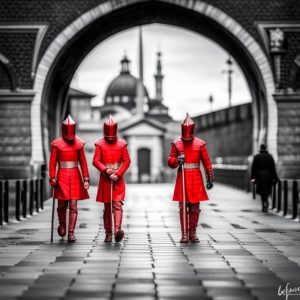



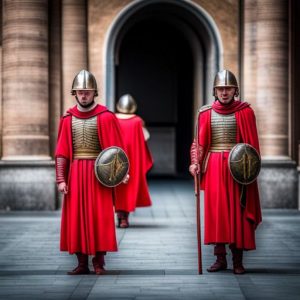
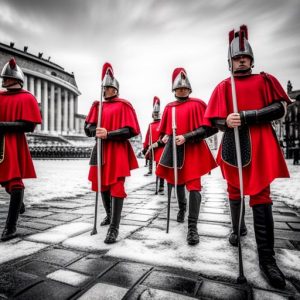

Step back in time to ancient Rome and meet the Praetorian Guard – a fierce group of elite soldiers who served as the emperor’s personal bodyguards. These highly trained and well-equipped soldiers were handpicked from the Roman army’s most experienced and loyal troops, stationed at the Praetorian Camp in Rome.
Created by Emperor Augustus in 27 BC, the Praetorian Guard’s mission was clear: to protect the emperor and his family at all costs. But their role extended far beyond mere protection. These soldiers were also a powerful political force, involved in the selection and deposition of emperors. Their influence was felt throughout the Roman Empire, and their loyalty to the emperor was absolute.
Despite their reputation as a formidable and feared force, the Praetorians were not without their flaws. They were infamous for their corruption and greed, often demanding bribes and special privileges from the emperors they served. However, in AD 41, these guardians of the Emperor did the unthinkable: they assassinated the controversial ruler, Caligula. Renowned for his outlandish cruelty and extravagant lifestyle, Caligula had a notorious reputation for executing prominent senators and indulging in scandalous behavior. The Praetorian Guard, who were responsible for his safety, had finally grown sick of his excesses and decided to take matters into their own hands. It was on January 24, AD 41, as Caligula was departing the theater, that a group of Praetorian soldiers attacked him. The Emperor was stabbed to death, and his uncle, Claudius, was proclaimed as the new Emperor. Throughout their history, they were involved in numerous conspiracies and plots that threatened the stability of the government.
The Praetorian Guard’s actions were both unprecedented and illegal. They had dishonored their oath of loyalty to the Emperor and had taken law enforcement into their own hands. However, their decision was also a reflection of the instability and uncertainty of the times. The Roman Empire was in a state of flux, and the Praetorian Guard was one of the few institutions with the power to act decisively. This pivotal moment in Roman history marked the beginning of a new era of imperial politics.
Despite these shortcomings, the Praetorian Guard remains an important part of Roman history. Their legacy lives on, even after the fall of the Western Roman Empire in 476 AD. So if you’re fascinated by ancient history, take a closer look at the legacy of the Praetorian Guard and discover the stories of these powerful and complex soldiers.
Tiberius Caesar Augustus: Unveiling the Secrets of Rome’s Enigmatic Emperor
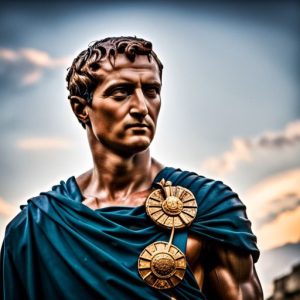
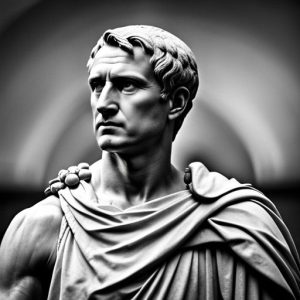
Step back in time to Ancient Rome and meet Tiberius Caesar Augustus, the second Roman Emperor who ruled from 14 AD to 37 AD. Born on November 16, 42 BC, in Rome, Tiberius’ childhood was far from ordinary. His parents divorced when he was young, and his father was exiled for supporting Julius Caesar. Thankfully for Tiberius, his stepfather, Augustus, adopted him and made him his heir in 4 AD.
As Emperor, Tiberius was a military mastermind, leading successful campaigns in Germany, Pannonia, and Illyricum, which helped to expand the Roman Empire’s territory. However, his reclusive nature, paranoia, and cruelty meant he wasn’t popular with the people or the Senate. He withdrew from public life and allowed his Praetorian Prefect, Sejanus, to take on most of his duties. Little did Tiberius know that Sejanus was plotting against him.
Tiberius’ reign was marked by political intrigue and scandals. He had his own son, Drusus, executed on false charges, and the infamous Sejanus Affair saw Sejanus and his family and supporters executed for treason. Scandal also followed Tiberius personally, as he was accused of sexual deviancy and having a relationship with his nephew, Gaius Caesar Germanicus, who he later adopted as his successor.
Despite his mixed legacy, Tiberius was regarded as a capable administrator and military strategist. He paved the way for the political and social changes that would shape the Roman world for centuries to come. Tiberius died on March 16, 37 AD, in Misenum, at the age of 77. His reign marked the transition from the Republic to the Empire, and his successor, Gaius, better known as Caligula, was even more notorious for his excesses and cruelty.
Eternal Echoes: Reflecting on Martin Luther King Day’s Call to Action
Martin Luther King Day, a day of immense significance, holds a place of prominence in our collective consciousness as it commemorates the extraordinary achievements and enduring legacy of the iconic leader, Dr. Martin Luther King Jr., who fearlessly spearheaded the civil rights movement. This annual occasion serves as a poignant reminder—an evocative testament—of Dr. King’s unwavering dedication and profound sacrifices in his relentless fight against racial discrimination and societal inequality within the United States.
As university students, this day prompts us to engage in deep introspection, fostering a deep-rooted sense of self-awareness, as we acknowledge the formidable progress we have made in our resolute pursuit of equality and justice. Simultaneously, it compels us to recognize the formidable challenges that persist and loom on the horizon.
Dr. King’s profound words, eloquently expressed in his legendary “I Have a Dream” speech, continue to reverberate throughout subsequent generations, igniting an indomitable spark of passion within our hearts. They serve as an enduring reminder—an impassioned wake-up call—of the imperative need to stand up against any form of injustice. Martin Luther King Day transcends being a mere commemoration of the remarkable life and accomplishments of this influential figure; it serves as a resounding clarion call—a stirring summons—to action, compelling individuals and communities alike to persevere untiringly in the pursuit of constructing a truly inclusive and equitable society.
This momentous day urges us to reflect upon the profound power of nonviolent resistance, underscoring the remarkable influence that can be wielded by a single impassioned soul—a single agent of change—in effecting positive transformation. By celebrating Martin Luther King Day, we not only pay homage to Dr. King’s visionary ideals, but also reaffirm our unwavering commitment to his teachings of love, compassion, and equality. It serves as a resolute reminder—a steadfast admonition—encouraging us to uphold these eternal values and to tirelessly labor towards the creation of a world emancipated from the shackles of discrimination and prejudice. United, let us honor Dr. King’s enduring vision; a vision that propels us towards a society where individuals are judged, not by the color of their skin, but by the richness of their character.
Michael the Magnificent: Unveiling the Warrior Archangel’s Legacy
Renowned for his role as the supreme commander of the celestial army, Archangel Michael commands the attention of believers and spiritual seekers alike. With unwavering commitment, he stands as a formidable warrior, transcending religious boundaries and captivating the imaginations of those who encounter his legend.
In the depths of his name lies a profound question: “Who is like God?” This translation from Hebrew reflects the core attributes of righteousness and divine potency that define Michael’s essence. Leading the angelic forces, he navigates the cosmic battle against the forces of evil and darkness with unparalleled skill and determination.
Texts and artworks paint vivid portraits of Michael as a warrior angel, radiating a commanding presence while brandishing his sword or spear. His tireless dedication to upholding justice and safeguarding the celestial realm has earned him immense respect and admiration from devout adherents.
As a symbol of divine protection, Michael becomes a refuge for those seeking solace and guidance during trying times. Countless individuals turn to him, drawing strength from his unwavering spirit. His ability to vanquish malevolent entities is unmatched, solidifying his reputation as the epitome of bravery, righteousness, and spiritual fortitude.
Across the globe, the portrayal of Archangel Michael as a formidable warrior and esteemed leader continues to inspire and captivate hearts. His legend resonates through the pages of literature, the strokes of art, and the practices of various religions.
Unveiling the Shadows of the Past: The Second Opium War – Clash of Empires in the 19th Century
Transport yourself back to the mid-19th century, where an epic clash unfolded between civilizations in the form of the Second Opium War, famously known as the Arrow War. This captivating conflict spanned from 1856 to 1860, pitting the mighty Qing Dynasty of China against a coalition of Western powers, spearheaded by Britain and France.
At the heart of this momentous battle lay the highly disputed issue of opium trade, which had simmered as a source of tension between China and the West for years. The Qing government, resolute in its determination to combat the devastating grip of opium addiction on its people, bravely took action by cracking down on the trade. In an unintended consequence, they seized and destroyed opium stocks owned by British merchants, which inadvertently triggered a violent clash between British and Chinese forces in 1856. Little did they know that this seemingly minor skirmish would mark the inception of a full-blown war.
Day by day, the conflict gained momentum, drawing other Western powers like France and the United States into the fray. These nations rallied alongside Britain, united by their mission to safeguard their commercial interests within China’s borders. The Second Opium War unfolded as a series of gripping naval and land battles, ultimately resulting in the triumph of the Western powers.
In 1858, the Treaty of Tientsin was signed, and two years later, the Treaty of Peking brought an end to the hostilities. These pivotal agreements coerced the Qing government into making significant concessions. The once-outlawed opium trade was now legalized, more ports were opened up for Western commerce, and the prized jewel of Hong Kong was transferred into British hands.
The ramifications of the Second Opium War reverberated throughout China, leaving an indelible mark on its history. Not only did it further weaken the already crumbling Qing Dynasty, but it also exposed the nation to intensified Western influence and exploitation. This conflict laid bare the stark power imbalance between China and the West, forever altering the course of events. Its reverberations acted as a catalyst for subsequent uprisings, such as the Boxer Rebellion, ultimately contributing to the downfall of the Qing Dynasty.
Without a doubt, the Second Opium War remains an integral chapter in Chinese history, representing a crucial moment of confrontation between traditional Chinese society and the unyielding forces of Western imperialism. Let it stand as a reminder of the enduring struggle for power and the profound impact it can have on the destiny of a nation.
The First Opium War: A Clash of Empires and the Battle for Control
Transport yourself back to the early 19th century and bear witness to a significant clash between two formidable forces – China and the British Empire. This momentous struggle, commonly known as the First Opium War, unfolded from 1839 to 1842 and left a lasting impact on their relationship.
At the heart of this conflict was the insidious opium trade, a destructive force that wreaked havoc on Chinese society. Through cunning and deceit, the British, acting through the powerful British East India Company, covertly smuggled opium from their Indian territories, flooding the Chinese market. The consequences were devastating. Addiction rapidly spread among the Chinese people, causing widespread devastation and pushing the nation into a deep economic crisis.
Motivated by a strong desire to put an end to this harmful trade, the Chinese imperial government launched a forceful crackdown, confiscating and destroying large quantities of opium. However, they did not anticipate that this act of defiance would ignite a full-blown conflict. Fiercely protecting their economic interests, the British swiftly retaliated with a resolute and decisive military response.
With superior firepower and unmatched naval capabilities, the British forces unleashed their might upon China. The battlefront witnessed a relentless series of significant victories as the British captured crucial coastal cities, including the highly desirable territories of Canton and Shanghai. Overwhelmed and outmatched, the Chinese succumbed to the relentless assault.
The climax of the war came with the signing of the Treaty of Nanking in 1842, a fateful agreement that burdened China immensely. According to its provisions, China was compelled to surrender Hong Kong to the British, open multiple ports for foreign trade, pay substantial indemnity, and grant extraterritorial rights to British citizens. This unequal treaty left China deeply humiliated, exposing its military weaknesses and setting the stage for a prolonged period of foreign dominance and subjugation by Western powers.
Simultaneously, the First Opium War solidified the British Empire’s control over East Asia, unlocking unprecedented opportunities for trade and expansion. It served as a remarkable stage to showcase their military strength and unrivaled naval superiority, leaving no doubt about the extent of their global influence.
The reverberations of this pivotal event extended far beyond its immediate consequences, leaving an enduring impact on the relationship between China and Western powers. For China, it acted as a powerful catalyst for change, awakening a strong desire for reform and modernization. The war ignited a profound sense of national humiliation among its people, propelling the nation towards grappling with the challenges posed by a rapidly evolving world.
In stark contrast, the British Empire reveled in its triumph, bolstering its supremacy within the region and unlocking new avenues for trade and expansion. The First Opium War became a platform to demonstrate their military might while leaving a lasting legacy of British military technology and naval dominance.
As the dust settled, it became increasingly clear that the First Opium War was more than a mere footnote in history. It fundamentally reshaped the course of events, forever altering the dynamics between China and Western powers. It stands as a monumental testament to the clash of empires fought over the intoxicating allure of power and control.
Okinawa Chronicles: Navigating Centuries of Culture and Valor
Prepare to be captivated by the riveting tale that unravels the history of Okinawa, a mesmerizing journey that stretches across centuries and is shaped by a tapestry of cultures and a tumultuous past. Nestled in the southernmost corner of Japan, Okinawa boasts a captivating and diverse history that sets it apart from the mainland. Embark on a historical odyssey that traces its roots back to the esteemed Ryukyu Kingdom, a flourishing empire that thrived from the 14th to the 19th century.
During this golden era, Okinawa emerged as a bustling maritime hub, connecting the realms of East Asia and Southeast Asia in an intricate web of trade, diplomacy, and cultural exchange. The Ryukyu Kingdom’s zenith witnessed an extraordinary fusion of influences from far and wide, with traces of China, Japan, Korea, and even Southeast Asian nations making their indelible mark on the island’s identity.
However, the kingdom faced its fair share of trials and tribulations, grappling with challenges posed by neighboring powers, including the formidable Satsuma domain in Japan. The late 19th century marked a turning point in Okinawa’s narrative as it was annexed by Japan, forever altering the course of its history.
With the advent of World War II, Okinawa was thrust into the spotlight as a vital military stronghold for Japan. It became a theater of war, witnessing one of the bloodiest battles in the Pacific – the Battle of Okinawa in 1945. A devastating conflict that exacted an immense toll, claiming thousands of lives and leaving widespread destruction in its wake.
In the aftermath of the war, Okinawa found itself under the control of the United States, which established military bases on the island. It wasn’t until 1972 that Okinawa regained its autonomy and returned to Japanese administration, marking yet another chapter in its ever-evolving narrative.
Today, Okinawa stands as a testament to the resilience of its people and the rich tapestry of its past. Its vibrant culture, awe-inspiring natural beauty, and heartfelt hospitality beckon visitors from far and wide. Experience the allure of Okinawa’s historical legacy, as its unique traditions come to life through the enchanting melodies of Ryukyuan dance, the echoes of traditional music, and the tantalizing flavors of its cuisine.
Moreover, Okinawa occupies a hallowed place in the annals of martial arts, for it is the very birthplace of karate. Its rich heritage continues to draw enthusiasts and curious souls from across the globe, eager to explore the island’s historical sites, bask in the splendor of its pristine beaches, and delve into the captivating tales of its past.
So, venture forth and immerse yourself in the captivating saga of Okinawa, a treasure trove of history, culture, and natural wonders that will leave an indelible impression on your heart and mind.
Sexpionage Unveiled: The Allure and Intrigue of Intimate Espionage
The fusion of “sex” and “espionage” gives rise to the captivating concept of sexpionage, unearthing a realm of mystery where intimate relationships evolve into formidable tools for gathering intelligence and manipulating outcomes. Throughout the course of history, intelligence agencies and agents have embraced this clandestine practice in their pursuit of sensitive information extraction, compromising targets, and exerting control over influential individuals. While the utilization of sex for intelligence purposes is not a novel idea, it reached its zenith during the gripping era of the Cold War, with both the Soviet Union and the United States eagerly employing sexpionage tactics, leaving an indelible mark on the annals of espionage.
At the core of this covert technique lies the recruitment of agents possessing alluring qualities, aptly termed as “honey traps,” who establish captivating connections with high-ranking officials or individuals of interest. These agents undergo specialized training to adeptly exploit their charm, physical attractiveness, and sexual prowess. Their mission? To gain access to classified information and exert their influence over unsuspecting targets. Sexpionage manifests in various forms, spanning from seduction and blackmail to the ingenious use of hidden cameras or recording devices during intimate encounters.
Nevertheless, this fascinating practice raises ethical concerns, treading a delicate line between manipulation, invasion of privacy, and the potential for exploitation. Moreover, its implications extend far beyond personal boundaries, posing significant risks to national security. The integrity of sensitive information may be jeopardized, and trust within diplomatic relations could be undermined. The ethical dilemmas surrounding sexpionage are as intricate as they are thought-provoking.
Despite the controversy enveloping it, sexpionage continues to captivate the human imagination, finding its place in literature, films, and popular culture, forever igniting fascination and intrigue. It serves as a constant reminder of the intricate and multifaceted world of espionage, where covert operations transcend traditional methods, delving into the realm of personal relationships and intimate encounters.
The Rise of Augustus: Unveiling the Legendary Emperor Who Shaped Ancient Rome

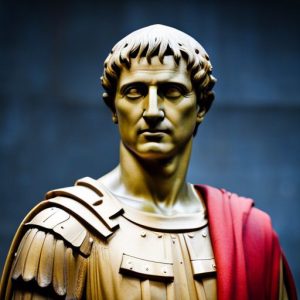
Meet Augustus Caesar, one of the most remarkable individuals in the history of Rome. Born as Gaius Octavius in 63 BC, he inherited great wealth and political power from his great-uncle Julius Caesar after he was assassinated when Augustus was only 18 years old. He quickly established himself as an outstanding politician and military leader, and at age 19, he joined forces with Mark Antony and Marcus Aemilius Lepidus to form the Second Triumvirate.
Augustus’s reign was marked by significant reforms and innovations that transformed Rome into a prosperous and peaceful empire. He restructured the Roman government, implementing a system of provinces and establishing a civil service to manage them. He also introduced a new currency system and constructed an extensive network of roads and aqueducts that connected far-flung territories.
Augustus was a patron of the arts and architecture, commissioning many of the great works of the time, such as the Mausoleum of Augustus, the Temple of Caesar, and the Ara Pacis. His leadership brought a period of peace and prosperity known as the Pax Romana, which was characterized by unprecedented economic growth and social stability.
Despite his many accomplishments, Augustus’s reign was not without controversy. He faced several challenges to his authority, including a revolt led by his daughter Julia’s ex-husband, and a rebellion in Germany led by Arminius. He was also criticized for his authoritarian rule and the ruthless tactics he used to maintain his power.
Augustus Caesar’s impact on Rome and the world cannot be overstated. His legacy lives on in the many structures and monuments he commissioned and in the numerous reforms and innovations he introduced during his reign. Even today, Augustus remains a fascinating and influential figure, and his contributions to history continue to inspire and captivate people worldwide.
Angelic Harmony: Unveiling the Roles of the Seven Archangels
In various religious and spiritual traditions, the concept of archangels holds immense significance, with Christianity, Judaism, and Islam being particularly notable examples. Within the Christian faith, believers hold the belief that there are seven archangels, each playing vital roles in divine interventions and serving as intermediaries between humanity and God. These archangels, namely Michael, Gabriel, Raphael, Uriel, Raguel, Remiel, and Saraqael, possess distinct qualities and assume specific responsibilities.
Michael, often portrayed as a formidable warrior, holds the esteemed position of leader within the heavenly army. He diligently safeguards the devout from the clutches of evil forces. Gabriel, known as the messenger angel, specializes in delivering significant announcements and revelations, serving as a conduit of divine communication. Raphael, recognized as the healing angel, offers solace and guidance to those grappling with physical, emotional, or spiritual afflictions, nurturing their recovery and well-being.
Uriel, the angel of wisdom, possesses the unique ability to enlighten mortal beings’ minds, imparting transcendental knowledge and guidance. Raguel, the angel of justice, tirelessly ensures fairness and a harmonious equilibrium within the celestial realms, upholding a sense of order. Remiel, the angel of hope, instills individuals with renewed optimism during times of hardship, inspiring resilience and fortitude within their hearts.
Lastly, Saraqael, the angel of guidance, wholeheartedly assists spiritual seekers on their profound journeys, directing them towards divine truths and enlightenment. While the specific roles and significance of these archangels may vary across different religious traditions, their celestial presence universally symbolizes divine protection, unwavering guidance, and sincere assistance for believers. Consequently, their existence brings comfort and hope in the face of overwhelming adversity.
Journey to Tranquility: Exploring the Twofoot Family Hobbit Home – A Haven of Warmth, Wonder, and Whimsy
Step into the realm of the Twofoot Family Hobbits, where you are transported to a whimsical world brimming with comfort and tranquility. Upon entry, you are greeted by a warm and inviting atmosphere, courtesy of a rustic stone fireplace crackling with a cozy fire. The air carries the earthly scent of oak beams, harmonizing with the soft candlelight to create an ambiance of serenity and contentment. The hobbit abode is thoughtfully adorned with rustic furnishings and charming details, including meticulously crafted hand-carved wooden furniture and exquisite tapestries depicting scenes from the mesmerizing Middle-earth. The walls proudly display shelves adorned with books, trinkets, and cherished family heirlooms, enveloping the space in a comforting aura of warmth and affection. The low ceiling, contrary to its potential constraining nature, fosters an intimate and secure ambiance. Every meticulously crafted piece of furniture boasts plush cushioned seats and tables fashioned from rich, dark wood. Gentle natural light filters through the round windows, casting a soothing glow upon the earth-toned interior.
The heart of activity lies within the kitchen, where a large wooden table acts as a gathering place for the family to share meals and stories. The air is infused with the enticing aroma of freshly baked bread and hearty stews, captivating the senses and evoking a sense of culinary delight. The bedrooms exude comfort and coziness, with snug beds nestled in alcoves, providing a peaceful haven for rest and rejuvenation. Stepping outside, you are greeted by a breathtaking hobbit garden, teeming with vibrant flowers, winding paths, and a small vegetable patch. The Twofoot Family Hobbit home stands as a sanctuary, a haven where time seemingly stands still, allowing you to escape the frantic pace of the outside world and embrace the simplicity and tranquility intrinsic to hobbit life.
It is a sanctuary of peace and serenity, where the burdens and worries of the external realm dissipate. The moment you enter this enchanting abode, you encounter a delightful living area beckoning you to sink into plush armchairs, enveloped by the crackling warmth of the fireplace, inviting you to indulge in the pleasures of a good book or engage in lively conversations with kindred spirits. The kitchen, adorned with gleaming copper pots and pans, transforms into a haven of culinary creativity, where delectable meals are lovingly prepared and shared around a generously-sized communal table. The bedrooms, tucked away in cozy alcoves, provide a sanctuary conducive to tranquility and renewal, offering sumptuous feather beds and windows framing breathtaking views of rolling hills and verdant gardens. As you venture outside, you encounter the Twofoot Family Hobbit home embraced by a picturesque landscape of vibrant meadows, babbling brooks, and majestic trees, enticing you to embark on leisurely strolls or extraordinary adventures.
Whether you choose to explore the charming villages of the Shire, partake in festive gatherings at the Green Dragon Inn, or simply revel in the serenity of your hobbit home, you will discover that the Twofoot Family Hobbit home is a haven where cherished memories are made and enduring friendships are formed. Step into this magical dwelling and experience firsthand the warmth and wonder that epitomize the hobbit way of life. Welcome to the Twofoot Family Hobbit home, where dreams become reality, and the ordinary transforms into the extraordinary.
Background information on the Twofoot Family and their occupation:
Nestled within the enchanting realm of Middle-earth, one discovers a unique and exclusive calling held by the Twofoot family of hobbits. These diminutive beings, measuring a mere two feet in height, possess an extraordinary talent for the intricate art of basket repair. With dexterous fingers and an acute eye for detail, hobbits have honed their expertise over generations, breathing new life into baskets of all shapes and sizes.
The craftsmanship of hobbits as basket repairers has garnered widespread recognition, garnering high esteem from not only fellow hobbits but also other inhabitants of Middle-earth. Whether it be a practical woven wicker basket used on arduous journeys or an ornate decorative piece adorning the shelves of a hobbit’s cozy abode, hobbit basket repairers boast the knowledge and finesse required to restore these functional and visually pleasing vessels. Approaching their work with utmost pride and reverence, hobbits display meticulous attention to detail and an unwavering commitment to preserving the integrity of each basket. They fully comprehend the essential role that these artifacts play in the everyday lives of the hobbit community.
Baskets seamlessly integrate into the fabric of hobbit life, serving in tasks ranging from gathering fresh produce from abundant gardens to safeguarding precious belongings. The occupation of basket repair undertaken by Twofoot hobbits not only showcases their practical expertise but also demonstrates their deep connection to nature and their dedication to sustainable living. By mending and repurposing baskets, hobbits minimize waste and contribute to the conservation of their natural surroundings. This vocation acts as a testament to their harmonious coexistence with the land, paying homage to the resources bestowed upon them by their beloved Middle-earth.
In the serene land of the Shire, the dwelling place of hobbits, one can find basket repairers toiling away in charming workshops nestled amidst the idyllic backdrop of rolling green hills and picturesque landscapes. It is within these hallowed grounds that hobbits gather to share knowledge, exchange techniques, and pass down their craft to younger generations. The art of basket repair serves as more than a mere trade; it embodies the essence of the hobbit way of life, characterized by simplicity, communal bonds, and a profound appreciation for the inherent beauty found in everyday objects.
Therefore, the next time you encounter a meticulously restored basket in Middle-earth, take a moment to appreciate the craftsmanship of the Twofoot hobbit and the legacy perpetuated through their occupation of basket repair.




